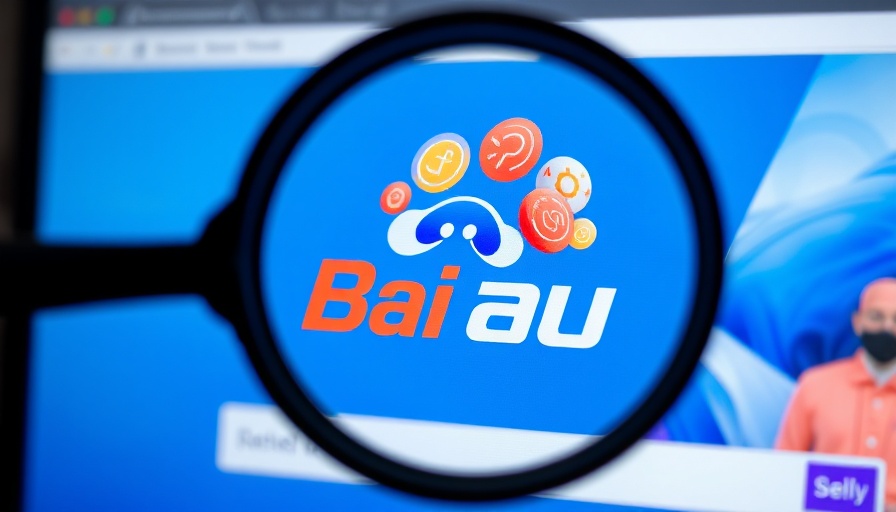
The New Era of AI: Baidu's Ernie Models
In a rapidly evolving technological landscape, Baidu, the Chinese search engine giant, has made a significant leap forward with the launch of two new artificial intelligence (AI) models – Ernie 4.5 and Ernie X1. These models promise to enhance the capabilities of AI systems, bringing competition to the forefront as companies like OpenAI and the newcomer DeepSeek reshape the industry.
Understanding the Innovations: Ernie 4.5 and Ernie X1
At the heart of Baidu's latest endeavor is Ernie 4.5, a multimodal foundation model that boasts the ability to process not only text but also video, images, and audio. This model is purported to outperform OpenAI's GPT-4.5 in various benchmarks while being offered at a fraction of the cost – just 1% of its counterpart. Such attributes make it ideal for diverse applications across different industries.
Meanwhile, Ernie X1 focuses on reasoning capabilities, being pitched as a direct rival to DeepSeek's R1 model. Baidu claims that Ernie X1 delivers performance on par with R1 at only half the price, highlighting its potential for cost-effective solutions in AI reasoning tasks. The introduction of X1 is critical, especially as it operates with advanced understanding and reflection capabilities – characteristics that are essential for developing intelligent systems capable of autonomous decision-making.
Why Open Source Matters in AI Development
Another significant aspect of this launch is the push towards open-source models within the AI realm. Baidu has announced that both Ernie models will be open-sourced, signaling a shift that could promote wider adoption and collaboration across the tech community. As Robin Li, CEO of Baidu, stated, the openness of a model can stimulate curiosity and drive usage.
The trend towards open-source solutions not only facilitates innovation but also levels the playing field, allowing developers and companies to contribute to and enhance existing AI frameworks. In contrast, proprietary models can often limit flexibility and user engagement, ultimately hindering the pace of technological advances.
Market Dynamics: The Impact of Competitive Pricing
Baidu's Ernie models arrive in the marketplace amid cut-throat competition, particularly from DeepSeek, a newcomer that has captured attention with its disruptive pricing strategy. DeepSeek's recent AI offerings have demonstrated capabilities comparable to leading edge models from established companies like OpenAI, which have traditionally dominated the sector. With prices significantly lower than those offered by OpenAI and Baidu, this pricing strategy could change the game.
The financial implications are substantial; for instance, Baidu's pricing claims suggest that using its models could save enterprises dramatically, with costs for tokens processed being as low as 0.004 Chinese yuan per thousand input tokens. Such cost advantages can incentivize businesses, particularly startups and smaller companies, to integrate advanced AI functionalities without breaking the bank.
Broader Implications for AI Adoption Worldwide
As the competition heats up, the implications are profound. Companies and developers are more likely to experiment with AI technology that is both affordable and versatile. Baidu’s launch of the Ernie models signals a determination to not only compete with American tech giants but also to position itself as a global leader in AI innovation.
Moreover, this launch corresponds with China’s strategic aim to become a leading technological power by 2030. By producing highly competitive models, Baidu is elevating China's status in the global AI landscape, challenging the notion that innovation is predominantly an American-centric phenomenon.
Excitement from the Community and Future Prospects
Feedback from initial users of Ernie models has been overwhelmingly positive. Developers and tech enthusiasts alike have expressed enthusiasm about their performance capabilities, sparking a spirit of innovation and curiosity. Alvin Foo, a venture partner at Zero2Launch, remarked, “Been playing around with it for hours, impressive performance.”
Looking ahead, Baidu plans to unveil Ernie 5 later in the year, suggesting that the company is committed to ongoing improvements and developments in its AI suite. This is likely to keep users engaged and foster an ecosystem of continual improvement and advancements.
The launch of the Ernie models represents not just another step in Baidu's journey but a significant moment in the AI industry where pricing, model capabilities, and open-source formats could redefine user engagement and application of artificial intelligence. As Baidu continues to innovate, the global AI landscape is set to evolve, offering exciting new opportunities for businesses and developers.
Ready to Explore Baidu's AI Models?
For anyone intrigued by the potential of AI and looking to leverage advanced technology at an accessible cost, now is the perfect time to delve into Baidu’s Ernie 4.5 and X1 models. Understanding their capabilities can significantly impact how businesses and developers navigate the AI landscape.
 Add Row
Add Row  Add
Add 




 Add Row
Add Row  Add
Add 

Write A Comment